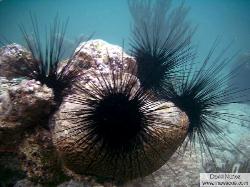

| Existen varias especies de erizos en el Caribe Mexicano, pero sin duda el más notable es el Diadema, con sus impresionantemente filosas, notablemente largas y usualmente negras espinas que pueden llegar a medir hasta 30 cm. Se alimentan principalmente de algas, y son uno de los herbívoros más importantes del arrecife, ya que mantienen el equilibrio entre corales y algas. Cuando su población se desplomó debido a una misteriosa epidemia entre 1983-84, numerosos arrecifes del Caribe murieron sofocados por las algas, lo cual repercutió en la disminución de la población de muchos peces y otras criaturas arrecifales. Muchos de estos arrecifes aun no se han recuperado, y las recuperaciones vistas han sido vinculadas a la reaparición de los Erizos Diadema. Se ha sugerido que previo a la muerte masiva de hasta un 97% de la población de Diademas entre 1983-84, su densidad de población se había elevado demasiado debido a la sobrepesca de sus depredadores. Y que esta densidad anormalmente elevada fue lo que facilitó la propagación de la enfermedad. Es decir, la sobrepesca redujo la población de depredadores. La ausencia de depredadores resultó en una sobrepoblación de Erizos Diadema. La alta densidad de población de los Diadema facilitó una epidemia catastrófica. La desaparición de los Erizos permitió el crecimiento desmedido de las algas, que acabaron sofocando al arrecife, matando ecosistemas enteros. Por esto, la historia de la Diadema es un recordatorio importante de la interdependenciade las especies, y de como los efectos sobre una sola pueden tener repercusiones dramáticas sobre el ecosistema entero. La verdad es que estamos vinculados a los demas seres vivos en maneras que no podemos siquiera imaginar. Por ello es importante actuar con un poco de humildad y precaución antes de alterar la naturaleza. |
Erizos Diadema
Diadema Sea Urchins
Diadema antillarum
Diadema Sea Urchins
Diadema antillarum
| There are several species of sea urchin to be found along the Mexican Caribbean, but by far the most notable is the Diadema, with its remarkably long, usually black, and extremely sharp spines, which can grow to 30 cm in length. They feed mostly on algae, and are one of the most important herbivores on the reef, as they maintain the balance between corals and algae. When their population crashed due to a mysterious epidemic in 1983-84, reefs throughout the Caribbean were smothered by algae and died, which in turn led to declines in the populations of many fish and other reef creatures. Many reefs have yet to recover, and recovery is strongly linked to a rebounding Diadema population. It has been suggested that prior to the die-off of up to 97% of Diadema urchins in 1983-84, their population was artificially high, due to overfishing of their predators. And that an abnormally high population density facilitated the spread of the disease. In other words, overfishing reduced the number of predators. This absence of predators resulted in overpopulation of Diadema Sea Urchins. The high population density of Diadema´s facilitated a catastrophic epidemic which nearly wiped them out. The disappearance of the Sea Urchins allowed algae to grow out of control, which ended up suffocating the reef and killing entire ecosystems. This is why the Diadema story is an important reminder of the interconnectedness of species, and how the effects on a single one can have long-ranging repercussions across the entire ecosystem. The truth is that we are connected to all other living beings in ways we cannot even begin to imagine. And because of that, we should act with a bit more caution and humility before interfering with nature. |
| Photos and text by David Nuñez |
| Recomendamos estos libros sobre la Fauna de México. (Los nuestros son bilingues.) |
| To learn more about the Wildlife of Mexico, we recommend the following books. |















